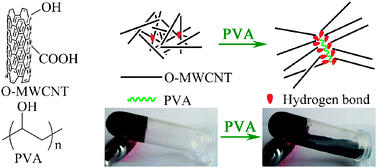A gel–sol transition phenomenon of oxidationmulti-walled carbon nanotubes–glycerol nanofluids induced by polyvinyl alcohol
Abstract

* Corresponding authors
a
State Key Laboratory of Solid Lubrication, Lanzhou Institute of Chemical Physics, Chinese Academy of Sciences, Lanzhou 730000, P. R. China
E-mail:
wjlou@licp.cas.cn
b Graduate School of Chinese Academy of Sciences, Beijing 100039, P. R. China
c
Key Laboratory of Colloid and Interface Chemistry, Shandong University, Ministry of Education, Jinan 250100, P. R. China
E-mail:
jhao@sdu.edu.cn
Fax: +86-531-88564750
Tel: +86-531-88366074

 Please wait while we load your content...
Something went wrong. Try again?
Please wait while we load your content...
Something went wrong. Try again?
B. Wang, W. Lou, X. Wang and J. Hao, New J. Chem., 2012, 36, 1273 DOI: 10.1039/C2NJ20977B
To request permission to reproduce material from this article, please go to the Copyright Clearance Center request page.
If you are an author contributing to an RSC publication, you do not need to request permission provided correct acknowledgement is given.
If you are the author of this article, you do not need to request permission to reproduce figures and diagrams provided correct acknowledgement is given. If you want to reproduce the whole article in a third-party publication (excluding your thesis/dissertation for which permission is not required) please go to the Copyright Clearance Center request page.
Read more about how to correctly acknowledge RSC content.
 Fetching data from CrossRef.
Fetching data from CrossRef.
This may take some time to load.
Loading related content
